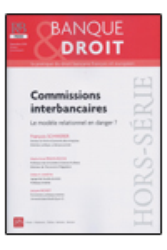
Updated: Feb. 6, 2017 (Initial publication: Jan. 5, 2015)
Publications

Bank and
If we plunge into this melting pot of incomprehension that engenders the violent clash between the banks, which evoke their mission, even their duty, and the
The more
It is therefore necessary to start from the undisputed existence of banking markets and the competitive mechanism which the law correlates with (I)). But the scale of the resistance reveals that it seems to have intentionally or not to have passed on the elementary and the essential: the very definition of what is a bank II. If it is accepted that the bank is the operator of the banking system, which fuels the economy as a whole, then
Dec. 16, 2010
Publications

Référence complète : FRISON-ROCHE, Marie-Anne, Les commissions interbancaires : le bras de fer entre concurrence et régulation, in Commissions interbancaire. Le modèle relationnel en danger ?, Banque Droit, numéro hors série, décembre 2010, p.6-8
La décision de l'Autorité de concurrence du 20 septembre 2010 dans l'affaire dite des "Images-chèques" illustre une confusion entre système de concurrence et système de régulation. En effet, sur un marché concurrentiel, les agents sont atomisés et leur mobilité permanente permet l'émergence des prix exacts, le prix étant la première référence du modèle. Mais certains secteurs sont marqués par une défaillance de marché, il en est ainsi du secteur bancaire, menacé par un risque systémique de défaillance en série des acteurs. Pour cela, le régulateur, la banque de France, met en place une régulation, sous-jacente au marché bancaire, qui assure des systèmes solides, stables et permanents dans le temps, accompagnés d'une sorte de tarification. L'autorité de concurrence a appréhendé ce système de régulation à travers le modèle inverse qu'est l'instabilité concurrentielle. Il s'agit là d'une confusion épistémologique dommageable.
Lire le résumé de l'article ci-dessous.
N.B. : la décision de l'Autorité de la concurrence a été sur recours réformée par la Cour d'appel de Paris.